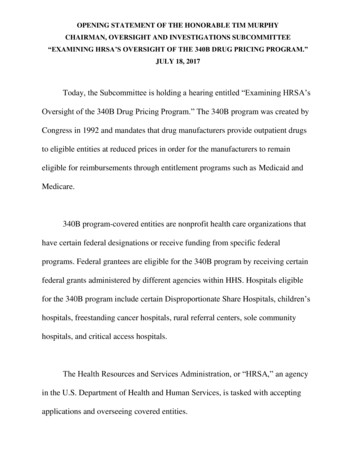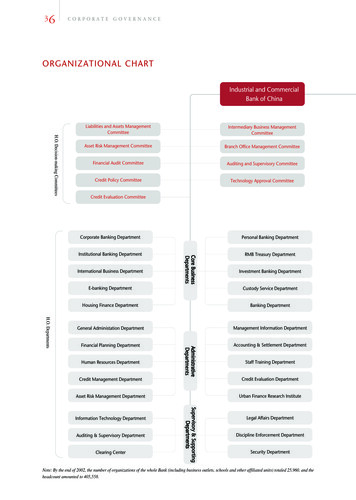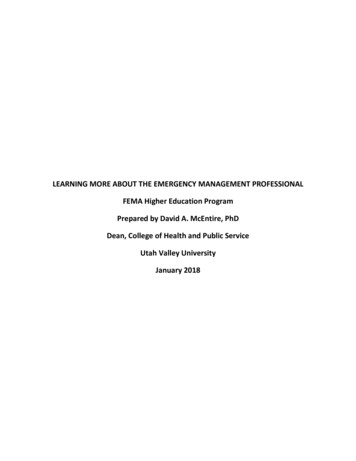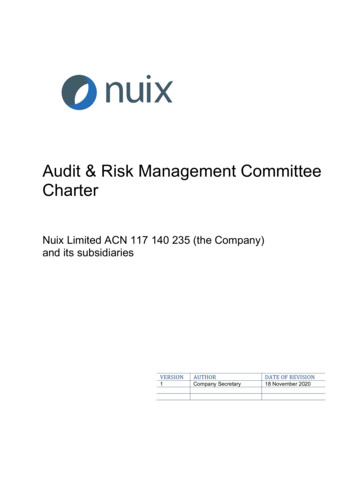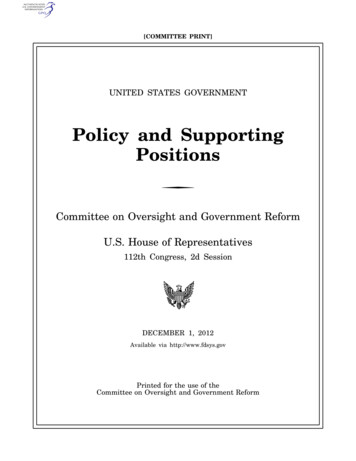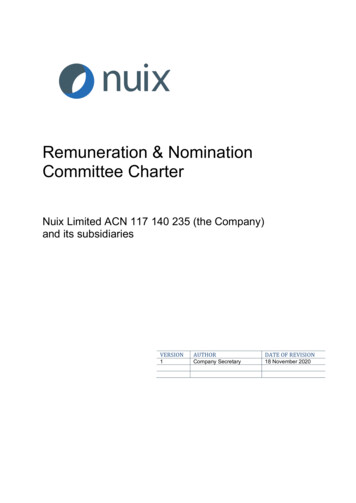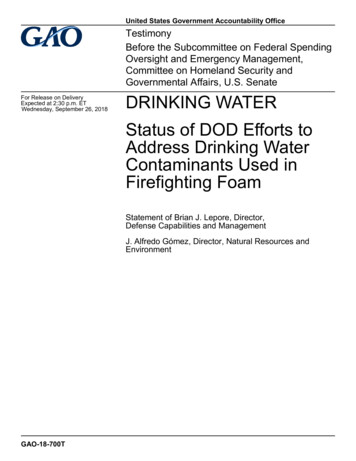
Transcription
United States Government Accountability OfficeTestimonyBefore the Subcommittee on Federal SpendingOversight and Emergency Management,Committee on Homeland Security andGovernmental Affairs, U.S. SenateFor Release on DeliveryExpected at 2:30 p.m. ETWednesday, September 26, 2018DRINKING WATERStatus of DOD Efforts toAddress Drinking WaterContaminants Used inFirefighting FoamStatement of Brian J. Lepore, Director,Defense Capabilities and ManagementJ. Alfredo Gómez, Director, Natural Resources andEnvironmentGAO-18-700T
September 26, 2018DRINKING WATERStatus of DOD Efforts to Address Drinking WaterContaminants Used in Firefighting FoamHighlights of GAO-18-700T, a testimonybefore the Subcommittee on FederalSpending Oversight and EmergencyManagement, Committee on HomelandSecurity and Governmental Affairs, U.S.SenateWhy GAO Did This StudyWhat GAO FoundAccording to health experts, exposureto elevated levels of PFOS and PFOAcould cause increased cancer risk andother health issues in humans. DODhas used firefighting foam containingPFOS, PFOA, and other PFAS sincethe 1970s to quickly extinguish firesand ensure they do not reignite. EPAhas found elevated levels of PFOS andPFOA in drinking water across theUnited States, including in drinkingwater at or near DOD installations.GAO reported in October 2017 that the Department of Defense (DOD) hadinitiated actions to address elevated levels of perfluorooctane sulfonate (PFOS)and perfluorooctanoic acid (PFOA) in drinking water at or near militaryinstallations. PFOS and PFOA are part of a larger class of chemicals called perand polyfluoroalkyl substances (PFAS), which can be found in firefighting foamused by DOD. In May 2016, the Environmental Protection Agency (EPA) issuednonenforceable drinking water health advisories for those two chemicals. Healthadvisories include recommended levels of contaminants that can be present indrinking water at which adverse health effects are not anticipated to occur overspecific exposure durations.This statement provides information onactions DOD has taken to addresselevated levels of PFOS and PFOA indrinking water at or near militaryinstallations and to address concernswith firefighting foam.This statement is largely based on aGAO report issued in October 2017(GAO-18-78). To perform the reviewfor that report, GAO reviewed DODpolicies and guidance related to PFOSand PFOA and firefighting foam,analyzed DOD data on testing andresponse activities for PFOS andPFOA, reviewed the four administrativeorders issued by EPA and stateregulators to DOD on addressingPFOS and PFOA in drinking water,visited seven installations, andinterviewed DOD and EPA officials.This statement also includes updatedinformation based on two 2018 DODreports to Congress—one on PFOSand PFOA response and one onfirefighting foam—as well asdiscussions with DOD officials.View GAO-18-700T. For more information,contact Brian J. Lepore at (202) 512-4523 orleporeb@gao.gov or J. Alfredo Gómez at(202) 512-3841 or gomezj@gao.gov.In response to those health advisories, DOD’s military departments directed theirmilitary installations to (1) identify locations with a known or suspected release ofPFOS and PFOA and address any releases that pose a risk to human health,which can include people living outside DOD installations, and (2) test for PFOSand PFOA in installation drinking water and address any contamination abovethe levels in EPA’s health advisories. For example: As of August 2017, DOD had identified 401 active or closed militaryinstallations with known or suspected releases of PFOS or PFOA. The military departments had reported spending approximately 200million at or near 263 installations for environmental investigations andresponses related to PFOS and PFOA, as of December 2016. Accordingto DOD, it may take several years for the department to determine howmuch it will cost to clean up PFOS and PFOA contamination at or nearits military installations. DOD reported taking actions (such as providing alternative drinkingwater and installing treatment systems) as of August 2017 to addressPFOS and PFOA levels exceeding those recommended in EPA’s healthadvisories for drinking water for people (1) on 13 military installations inthe United States and (2) outside 22 military installations in the UnitedStates.In addition to actions initiated by DOD, GAO reported in October 2017 that thedepartment also had received and responded to four orders from EPA and stateregulators that required DOD to address PFOS and PFOA levels that exceededEPA’s health advisory levels for drinking water at or near four installations.GAO also reported in October 2017 that DOD was taking steps to address healthand environmental concerns with its use of firefighting foam that contains PFAS.These steps included restricting the use of existing foams that contain PFAS;testing foams to identify the amount of PFAS they contain; and funding researchon developing PFAS-free foam that can meet DOD’s performance requirements,which specify how long it should take for foam to extinguish a fire and keep itfrom reigniting. In a June 2018 report to Congress, DOD stated that nocommercially available PFAS-free foam has met DOD’s performancerequirements and that research to develop such a PFAS-free foam is ongoing.United States Government Accountability Office
LetterLetterChairman Paul, Ranking Member Peters, and Members of theSubcommittee:Thank you for the opportunity to be here today to discuss our report onthe Department of Defense’s (DOD) attention to drinking watercontaminants, part of our body of work on the federal government’senvironmental liabilities. 1 The federal government is financially liable forcleaning up areas where federal activities have contaminated theenvironment. Today’s hearing addresses federal liability for andprocurement of per- and polyfluoroalkyl substances (PFAS), a large groupof man-made chemicals that include perfluorooctane sulfonate (PFOS)and perfluorooctanoic acid (PFOA). 2 PFOS, PFOA, and other PFAS canbe found in firefighting foam used by DOD since the 1970s for trainingand emergency response activities to put fires out quickly while alsoensuring that they do not reignite. 3Exposure to elevated levels of PFOS and PFOA could cause increasedcancer risk and other health issues in humans, according to the Agencyfor Toxic Substances and Disease Registry. The EnvironmentalProtection Agency (EPA) has found PFOS and PFOA in drinking wateracross the United States, including in drinking water at or near DODinstallations. EPA has not regulated PFOS and PFOA in drinking water,but EPA did issue nonenforceable drinking water health advisories forthese contaminants in May 2016, which we discuss further in thisstatement. Addressing PFOS and PFOA contamination represents apotentially significant environmental liability for DOD because the1In 2017, we added U.S. Government’s Environmental Liabilities to our areas identified asgovernment operations with greater vulnerabilities to fraud, waste, abuse, andmismanagement or in need for transformation to address economy, efficiency, oreffectiveness challenges. In fiscal year 2016 this liability was estimated at 447 billion (upfrom 212 billion in 1997) and is likely to continue to increase. The Department of Energyis responsible for 83 percent of these liabilities and DOD for 14 percent. Agencies spendbillions each year on environmental cleanup efforts but the estimated environmentalliability continues to rise. GAO, High-Risk Series: Progress on Many High-Risk Areas,While Substantial Efforts Needed on Others, GAO-17-317 (Washington, D.C.: Feb. 15,2017).2PFOS and PFOA are no longer manufactured in the United States but have been usedsince the 1940s. PFOS and PFOA have been the most extensively produced and studiedPFAS chemicals, and are very persistent in the environment and human body—meaningthey do not break down and can accumulate over time.3PFAS have also been used to make consumer products more resistant to stains, grease,and water; keep food from sticking to cookware; and make clothes and mattresses morewaterproof.Page 1GAO-18-700T Drinking Water
regulatory requirements are still evolving, the scientific community is stilldeveloping the underlying science, and the scope of work needed forcleanup is not yet known.In our statement today, we discuss actions DOD has taken to addresselevated levels of PFOS and PFOA in drinking water at or near militaryinstallations and to address concerns with DOD’s firefighting foam. Thisstatement is largely based on our October 2017 report on DOD’s effortsto manage contaminants in drinking water. 4 To perform our review for theOctober 2017 report, we reviewed DOD policies and guidance related toPFOS and PFOA and firefighting foam; analyzed DOD data on testingand response activities for PFOS and PFOA; reviewed four administrativeorders issued by EPA and state regulators; visited seven installations;and interviewed DOD and EPA officials. More detailed information on thescope and methodology for that work can be found in the issued report.This statement also includes updated information since our October 2017report, based on our review of two 2018 DOD reports to Congress—aMarch 2018 report on the department’s response to PFOS and PFOAcontamination and a June 2018 report on firefighting foam alternatives—and on our discussions with DOD officials about these issues and theiractions in September 2018. 5We conducted the work on which this statement is based in accordancewith generally accepted government auditing standards. Those standardsrequire that we plan and perform the audit to obtain sufficient, appropriateevidence to provide a reasonable basis for our findings and conclusionsbased on our audit objectives. We believe that the evidence obtained4GAO, Drinking Water: DOD Has Acted on Some Emerging Contaminants but ShouldImprove Internal Reporting on Regulatory Compliance, GAO-18-78 (Washington, D.C.:Oct. 18, 2017). In addition to PFOS and PFOA issues, we reported in October 2017 thatDOD had not internally reported all data on compliance with health-based drinking waterregulations. We also reported that DOD had not used available data to determine whysystems that provide DOD-treated water had different compliance rates from systems thatprovide non-DOD-treated water. We made five recommendations to improve DOD’sreporting and use of drinking water data. DOD concurred with the recommendations andin May 2018 reported actions that were planned or underway to implement them. Forexample, the military departments stated that they were providing training to theirinstallations on DOD’s drinking water reporting requirements. We will continue to monitorDOD’s status in implementing these recommendations.5The Deputy Assistant Secretary of Defense for Environment, Safety, and OccupationalHealth, Addressing Perfluorooctane Sulfonate (PFOS) and Perfluorooctanoic Acid (PFOA)(March 2018); Under Secretary of Defense for Acquisition and Sustainment, Departmentof Defense Alternatives to Aqueous Film Forming Foam Report to Congress (June 2018).Page 2GAO-18-700T Drinking Water
provides a reasonable basis for our findings and conclusions based onour audit objectives.BackgroundEPA regulates drinking water contaminants by issuing legally enforceablestandards under the Safe Drinking Water Act that generally limit the levelsof these contaminants in public water systems. 6 EPA has issued suchregulations for approximately 90 drinking water contaminants. Publicwater systems, including the DOD public water systems that providedrinking water to about 3 million people living and working on militaryinstallations, are required to comply with EPA and state drinking waterregulations.While EPA has not issued legally enforceable standards for PFAS indrinking water, the agency has monitored water systems in the UnitedStates for six types of PFAS chemicals—including PFOS and PFOA—inorder to understand the nationwide occurrence of these chemicals. 7 Thismonitoring effort was part of a larger framework established by the SafeDrinking Water Act to assess unregulated contaminants. Under thisframework, EPA is to select for consideration from a list (called thecontaminant candidate list) those unregulated contaminants that presentthe greatest public health concern, establish a program to monitordrinking water for unregulated contaminants, and decide whether or not toregulate at least 5 such contaminants every 5 years (called a regulatorydetermination). 86The term “public water system” refers to the provision of piped drinking water to thepublic, where the system serves at least 15 service connections or serves an average ofat least 25 people at least 60 days out of the year; it does not refer to whether the systemis publicly or privately owned.7This monitoring took place from 2013 through 2015 under EPA’s unregulatedcontaminant monitoring rule program. According to DOD, 63 DOD public water systemswere sampled during this time. For more information on EPA’s unregulated contaminantmonitoring rule program, see GAO, Drinking Water: EPA Has Improved Its UnregulatedContaminant Monitoring Program, but Additional Action is Needed, GAO-14-103(Washington, D.C.: Jan. 9, 2014).8PFOS and PFOA were placed on the contaminant candidate list in 2009 and again in2016. EPA met the time frame for publishing the first contaminant candidate list, but hasnot adhered to the 5-year cycle for subsequent lists.Page 3GAO-18-700T Drinking Water
EPA’s regulatory determinations are to be based on the following threebroad statutory criteria, all of which must be met for EPA to decide that adrinking water regulation is needed: the contaminant may have an adverse effect on the health of persons; the contaminant is known to occur or there is a substantial likelihoodthat the contaminant will occur in public water systems with afrequency and at levels of public health concern; and in the sole judgment of the EPA Administrator, regulation of suchcontaminant presents a meaningful opportunity for health riskreduction for persons served by public water systems.To date, PFOS and PFOA are unregulated because EPA has not made apositive regulatory determination for these chemicals.Even when EPA has not issued a regulation, EPA may publish drinkingwater health advisories. In contrast to drinking water regulations, healthadvisories are nonenforceable. 9 Health advisories recommend theamount of contaminants that can be present in drinking water—“healthadvisory levels”—at which adverse health effects are not anticipated tooccur over specific exposure durations. Most recently, in May 2016 EPAissued lifetime health advisories for PFOS and PFOA. 10 These advisoriesset the recommended health advisory level for each contaminant—orboth contaminants combined—at 70 parts per trillion in drinking water. 11According to DOD, the department also considers information in thesehealth advisories when determining the need for cleanup action atinstallations with PFOS and PFOA contamination.9EPA has issued administrative orders to address contaminated drinking water based onhealth advisory levels. We discuss such orders related to PFOS and PFOA later in thisstatement.10EPA, Drinking Water Health Advisory for Perfluorooctane Sulfonate (PFOS) (May 2016);EPA, Drinking Water Health Advisory for Perfluorooctanoic Acid (PFOA) (May 2016).These lifetime health advisories for PFOS and PFOA replaced provisional healthadvisories that were issued by EPA in January 2009, which set health advisory levels of200 parts per trillion for PFOS and 400 parts per trillion for PFOA.11One part per trillion is comparable to one drop in a swimming pool covering the area of afootball field 43 feet deep.Page 4GAO-18-700T Drinking Water
DOD Has InitiatedActions to AddressElevated Levels ofPFOS and PFOA inDrinking Water andConcerns withFirefighting FoamDOD Has Initiated Actionsto Identify, Test, Address,and Respond to Ordersfrom RegulatorsRegarding PFOS andPFOA in Drinking WaterWe reported in October 2017 that, following the release of EPA’s lifetimehealth advisory for PFOS and PFOA in May 2016, each of the militarydepartments directed their installations to identify locations with any known or suspected prior release of PFOSand PFOA and to address any releases that pose a risk to humanhealth—which can include people living outside DOD installations;and test for PFOS and PFOA in their drinking water and address anycontamination above EPA’s lifetime health advisory level.We further reported that, as of December 2016, DOD had identified 393active or closed military installations with any known or suspectedreleases of PFOS or PFOA. 12 Since we issued our report, DOD hasupdated that number to 401 active or closed installations, according toAugust 2017 data provided in a March 2018 report to Congress on thedepartment’s response to PFOS and PFOA contamination. 1312We reported in October 2017 that this number included 391 installations identified by themilitary departments and, according to DOD officials, 2 installations identified by theDefense Logistics Agency. DOD efforts to test for and respond to PFOS and PFOA atoverseas installations were outside the scope of our October 2017 report.13The Deputy Assistant Secretary of Defense for Environment, Safety, and OccupationalHealth, Addressing Perfluorooctane Sulfonate (PFOS) and Perfluorooctanoic Acid (PFOA)(March 2018). This report was provided in response to language included in House Report115-200, accompanying a bill for the National Defense Authorization Act for Fiscal Year2018.Page 5GAO-18-700T Drinking Water
We stated in our October 2017 report that the military departments hadreported spending approximately 200 million at or near 263 installationsfor environmental investigations and response actions, such as installingtreatment systems or supplying bottled water, as of December 2016. 14 The Air Force had identified 203 installations with known or suspectedreleases of PFOS and PFOA and had spent about 153 million onenvironmental investigations and response actions (accounting forabout 77 percent of what the military departments had spent on PFOSand PFOA activities as of December 2016). For example, the AirForce reported spending over 5 million at Peterson Air Force Base inColorado. During our visit to that installation in November 2016,officials showed us the current and former fire training areas that theywere investigating to determine the extent to which prior use offirefighting foam may have contributed to PFOS and PFOA found inthe drinking water of three nearby communities. Additionally, the AirForce had awarded a contract for, among other things, installingtreatment systems in those communities. The Navy had identified 127 installations with known or suspectedreleases of PFOS and PFOA and had spent about 44.5 million onenvironmental investigations and response actions (accounting forabout 22 percent of what the military departments had spent on PFOSand PFOA activities as of December 2016). For example, the Navyreported spending about 15 million at the former Naval Air StationJoint Reserve Base Willow Grove in Pennsylvania. 15 During our visitto that installation in August 2016, officials told us that the Navy wasinvestigating the extent to which PFOS and PFOA on the installationmay have contaminated a nearby town’s drinking water. At the time,the Navy had agreed to pay for installing treatment systems andconnecting private well owners to the town’s drinking water system,among other things. The Army had identified 61 installations with known or suspectedreleases of PFOS and PFOA and had spent about 1.6 million onenvironmental investigations (accounting for less than 1 percent of14DOD did not provide updated information on costs for responding to PFOS and PFOA inits March 2018 report to Congress. According to DOD data in our October 2017 report,204 of the 263 installations where environmental investigations and response actionsoccurred were active installations, and 59 had been closed under the Base Realignmentand Closure process—a process DOD has used to reduce excess infrastructure.15Naval Air Station Joint Reserve Base Willow Grove was closed under the 2005 BaseRealignment and Closure round.Page 6GAO-18-700T Drinking Water
what the military departments had spent on PFOS and PFOAactivities as of December 2016), but had not yet begun any responseactions. At the time of our October 2017 report, the Army had not yetcompleted testing its drinking water for PFOS and PFOA.DOD’s March 2018 report to Congress provided updated information onactions taken (such as providing alternative drinking water or installingtreatment systems) to address PFOS and PFOA in drinking water at ornear military installations in the United States, as shown in figure 1 below.Specifically, DOD reported taking action as of August 2017 to addressPFOS and PFOA levels exceeding those recommended in EPA’s healthadvisories for drinking water for people (1) on 13 military installations and(2) outside 22 military installations. 1616At the time of our October 2017 report, DOD data showed that the department hadinitiated actions to address PFOS and PFOA in the drinking water for people (1) on 11military installations, as of March 2017, and (2) outside 19 military installations, as ofDecember 2016. Two installations (Chanute Air Force Base and Wright-Patterson AirForce Base) that DOD had previously reported to us as locations where actions had beentaken to address PFOS and PFOA in drinking water outside the installations were notincluded in DOD’s March 2018 report. DOD officials told us in September 2018 that thereare no PFOS and PFOA impacts to drinking water outside these installations.Page 7GAO-18-700T Drinking Water
Figure 1: Military Installations Where DOD Has Reported Taking Action to Address Elevated Levels of PFOS and PFOA inDrinking Water, as of August 2017We reported in October 2017 that, in addition to actions initiated by DOD,the department also took action in response to state and federalregulators. DOD responded to four administrative orders requiring thatDOD address PFOS and PFOA levels that exceeded EPA’s healthadvisory levels for drinking water. One order was issued by the OhioEnvironmental Protection Agency at Wright-Patterson Air Force Base inOhio, and three orders were issued by EPA at the former Pease Air ForceBase in New Hampshire; Horsham Air Guard Station in Pennsylvania;Page 8GAO-18-700T Drinking Water
and the former Naval Air Warfare Center Warminster in Pennsylvania. 17For example, at Wright-Patterson Air Force Base, levels of PFOS andPFOA that exceeded EPA’s lifetime health advisory levels were found attwo wells on the installation in 2016. In response to the order from theOhio Environmental Protection Agency, the Air Force closed drinkingwater wells, installed new monitoring wells, and provided bottled water tovulnerable populations on the installation. Additional details on each orderand examples of actions by DOD to address the orders were reported onin our October 2017 report.According to DOD, it may take several years for the department todetermine how much it will cost to clean up PFOS and PFOAcontamination at or near its military installations. Additionally, DODofficials told us in September 2018 that they believe a legally enforceableEPA drinking water cleanup standard would ensure greater consistencyand confidence in their cost estimates because such a standard wouldgive them a consistent target to clean up to. In a January 2017 report onenvironmental cleanup at closed installations, we recommended thatDOD include in future annual reports to Congress best estimates of theenvironmental cleanup costs for contaminants such as PFOS and PFOAas additional information becomes available. 18 DOD implemented thisrecommendation by including in its fiscal year 2016 environmental reportto Congress (issued in June 2018) an estimate of the costs to respond toPFOS and PFOA. 1917Under Section 1431 of the Safe Drinking Water Act, EPA may issue orders necessary toprotect human health where a contaminant in a public water system presents an imminentand substantial endangerment and if appropriate state and local authorities have not actedto protect human health. Pub. L. No. 93-523 (1974). These orders may require, amongother things, carrying out cleanup studies, providing alternate water supplies, notifying thepublic of the emergency, and halting disposal of the contaminants threatening humanhealth. The Ohio Environmental Protection Agency has similar authority.18GAO, Military Base Realignments and Closures: DOD Has Improved EnvironmentalCleanup Reporting but Should Obtain and Share More Information, GAO-17-151(Washington, D.C.: Jan. 19, 2017).19Office of the Under Secretary of Defense for Acquisition and Sustainment, DefenseEnvironmental Programs Annual Report to Congress for FY 2016 (Washington, D.C.:June 2018).Page 9GAO-18-700T Drinking Water
DOD Has Taken Steps toAddress Health andEnvironmental Concernswith Its Firefighting FoamIn our October 2017 report, we found that DOD was taking steps toaddress health and environmental concerns with its use of firefightingfoam that contains PFAS. 20 These steps included restricting the use ofexisting foams that contain PFAS, testing DOD’s current foams to identifythe amount of PFAS they contain, and funding research into the futuredevelopment of PFAS-free foam that can meet DOD’s performance andcompatibility requirements (see table 1). 21 Some of these steps, such aslimiting the use of firefighting foam containing PFAS, were in place.Others, such as researching potential PFAS-free firefighting foams, werein progress at the time of our review.Table 1: Department of Defense (DOD) Steps to Address Concerns about Perfluorooctane Sulfonate (PFOS) andPerfluorooctanoic Acid (PFOA) in Firefighting FoamStepGoalActions/statusRestricting use offirefighting foamFollowing the May 2016 issuance of theEnvironmental Protection Agency’slifetime health advisory for PFOS andPFOA, the military departments issuedpolicies restricting the use of firefightingfoam at their installations.Actions called for in military department policies:Air Force: Stop routine testing of firefighting equipment unless thereleased foam can be contained and managed. Treat all releasesof firefighting foam with PFOS or PFOA as hazardous materialareleases.Navy: Stop the uncontrolled release of firefighting foam except inemergency situations. Ensure that any foam that is discharged in anonemergency situation is contained, captured, and properlybdisposed of.Army: Prohibit all nonemergency discharges of firefighting foam, tocinclude training and equipment testing.20Firefighting foam used by DOD contains other types of PFAS, in addition to PFOS andPFOA.21DOD’s military specification for firefighting foam outlines performance and compatibilityrequirements. For example, the specification states how long it should take for foam toextinguish a fire and prevent the extinguished fire from reigniting and requires thatfirefighting foam approved for use by DOD from one manufacturer be compatible withfoam from another manufacturer. At the time of our review, the military specification inplace for firefighting foam was DOD, Mil-F-24385F, Fire Extinguishing Agent, AqueousFilm Forming Foam (AFFF) Liquid Concentrate, for Fresh and Seawater (Aug. 5, 1994).Page 10GAO-18-700T Drinking Water
StepGoalTesting firefightingfoam with PFASDOD’s intent was to eventually replaceAccording to DOD, firefighting foams approved for purchase andthe existing firefighting foam that contains use by DOD since at least December 2015 do not contain PFOS,PFOS and PFOA.but these firefighting foams contain other types of PFAS and maycontain PFOA.The Naval Research Laboratory was testing the different types offirefighting foams that were approved for purchase and use byDOD to determine the extent to which they contain PFOA anddother types of PFAS. Testing was expected to continue until late2017 or 2018.Navy and Army officials said that they planned to wait for finaltesting results before deciding whether to select a specificfirefighting foam to replace the foam used at their installations. TheAir Force, however, had already selected a specific foam for use atits installations. This foam contains PFAS but, according to the AirForce, does not contain PFOS and contains little or no PFOA.Officials said that all Air Force installations in the continental UnitedStates had received this new foam.Actions/statusFunding firefightingfoam researchDOD was funding research into thedevelopment of PFAS-free firefightingfoam because DOD believes that such afoam would significantly reduce theenvironmental impact of fire suppressiontraining and operations, while maintainingthe safety of personnel from fire hazards.In October 2015, DOD’s Strategic Environmental Research andDevelopment Program issued a statement of need calling forproposals to develop a PFAS-free firefighting foam that can meetDOD’s performance requirements and be compatible with existingfoams and equipment.In fiscal year 2017, DOD funded three research projects thatresponded to the statement of need—one led by the Naval AirSystems Command, one led by the Naval Research Laboratory,and one led by a private firefighting foam manufacturer—with anestimated total cost of 2.5 million and an estimated completiondate of 2020.Source: GAO analysis of DOD data. GAO-18-700TaOffice of the Assistant Secretary of the Air Force for Installations, Environment, and EnergyMemorandum, SAF/IE Policy on Perfluorinated Compounds (PFCs) of Concern (Aug. 11, 2016).bOffice of the Assistant Secretary of the Navy for Energy, Installations, and EnvironmentMemorandum, Aqueous Film Forming Foam (AFFF) Control, Removal, and Disposal (June 17, 2016).cAssistant Chief of Staff of the Army for Installation Management Memorandum, Limiting Use o
monitoring effort was part of a larger framework established by the Safe Drinking Water Act to assess unregulated contaminants. Under this framework, EPA is to select for consideration from a list (called the contaminant candidate list) those unregulated contaminants that present the greatest public health concern, establish a program to monitor
